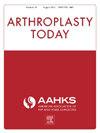Global Hip Offset is an Important Factor in the Success of Abductor Mechanism Insufficiency Repair After Total Hip Arthroplasty: A Case Series
IF 2.1
Q3 ORTHOPEDICS
引用次数: 0
Abstract
Background
Hip abductor mechanism deficiency due to abductor tendon degeneration, tear, or intraoperative damage during total hip arthroplasty (THA) may cause severe walking disability. For severe abductor weakness in native hip joints, Whiteside muscle transfer is a good solution. However, the literature on the results of abductor mechanism reconstruction (AMR) after THA remains limited. Our study aimed to assess the outcome of AMR in patients with THA suffering from Milwaukee III and IV hip abductor deficiency.
Methods
We conducted a single-center retrospective cohort study of THA with hip abductor mechanism deficiency treated surgically with AMR. Data were collected between January 2011 and December 2019 and included the following parameters: patient’s data, subjective level of pain, Harris Hip Score (HHS), gait pattern, extent of hip abductor tear, and offset measurements.
Results
The cohort included 16 THAs with AMR in 16 patients. The whole group median HHS improved from 37.1 interquartile range (IQR) (31.0-38.7) to 73.9 IQR (63.5-83.7) (P < .001). In a subgroup of 9 hips, the global offset was preserved after THA while it was reduced in remaining 7 hips. All patients with preserved global offset had significantly better clinical outcome compared to the group with reduced global offset (median HHS improvement was 48 IQR [46-53] compared to 22 IQR [18-25], P = .001).
Conclusions
Our study showed favorable outcome of the AMR for chronic, Milwaukee III and IV hip abductor deficiency after THA. It is the first study to show that restoration of global offset after THA is of utmost importance to avoid chronic abductor mechanism deficiency.
髋关节整体偏移是全髋关节置换术后外展机制不全修复成功的重要因素:一个病例系列
背景:在全髋关节置换术(THA)中,由于外展肌腱退变、撕裂或术中损伤引起的髋关节外展机制缺陷可能导致严重的行走障碍。对于严重的髋关节外展肌无力,怀特塞德肌肉转移是一个很好的解决方案。然而,关于THA后外展肌机制重建(AMR)结果的文献仍然有限。我们的研究旨在评估患有Milwaukee III型和IV型髋关节外展肌缺乏的THA患者AMR的结果。方法对髋关节外展机制缺陷行AMR手术治疗的THA患者进行单中心回顾性队列研究。数据收集于2011年1月至2019年12月,包括以下参数:患者数据、主观疼痛程度、哈里斯髋关节评分(HHS)、步态模式、髋关节外展肌撕裂程度和偏移测量。结果该队列包括16例AMR患者的16例THAs。全组HHS中位数由37.1(31.0-38.7)改善至73.9 (63.5-83.7)(P < .001)。在9髋的亚组中,THA后整体偏移量保留,而其余7髋的偏移量减少。与整体偏移减少组相比,所有保留整体偏移的患者的临床结果明显更好(HHS改善的中位数为48 IQR[46-53],而22 IQR [18-25], P = .001)。结论我们的研究显示AMR治疗髋关节置换术后慢性、Milwaukee III型和IV型髋关节外展肌缺损的预后良好。这是第一个研究表明,在THA后恢复整体偏移对于避免慢性外展机制缺陷至关重要。
本文章由计算机程序翻译,如有差异,请以英文原文为准。
求助全文
约1分钟内获得全文
求助全文
来源期刊

Arthroplasty Today
Medicine-Surgery
CiteScore
2.90
自引率
0.00%
发文量
258
审稿时长
40 weeks
期刊介绍:
Arthroplasty Today is a companion journal to the Journal of Arthroplasty. The journal Arthroplasty Today brings together the clinical and scientific foundations for joint replacement of the hip and knee in an open-access, online format. Arthroplasty Today solicits manuscripts of the highest quality from all areas of scientific endeavor that relate to joint replacement or the treatment of its complications, including those dealing with patient outcomes, economic and policy issues, prosthetic design, biomechanics, biomaterials, and biologic response to arthroplasty. The journal focuses on case reports. It is the purpose of Arthroplasty Today to present material to practicing orthopaedic surgeons that will keep them abreast of developments in the field, prove useful in the care of patients, and aid in understanding the scientific foundation of this subspecialty area of joint replacement. The international members of the Editorial Board provide a worldwide perspective for the journal''s area of interest. Their participation ensures that each issue of Arthroplasty Today provides the reader with timely, peer-reviewed articles of the highest quality.
 求助内容:
求助内容: 应助结果提醒方式:
应助结果提醒方式:


